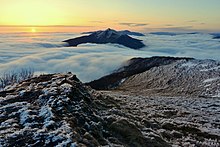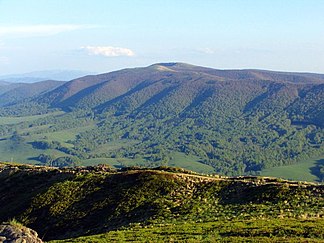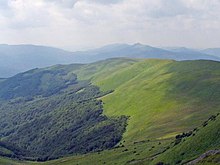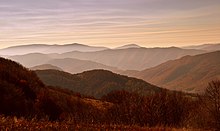Bieszczady
| Bieszczady | ||
|---|---|---|
|
View from Mała Rawka , 1272 m |
||
| Highest peak | Tarnica ( 1346 m npm ) | |
| location | Poland ( Ukraine ) | |
| part of | East Beskids | |
|
|
||
| Coordinates | 49 ° 10 ′ N , 22 ° 17 ′ E | |


The Bieszczady [ bʲɛ'ʃtʃadɨ ] ( Polish Bieszczady , Ukrainian Бескиди Beskydy ) are a mountain range of the Carpathian Mountains in the Subcarpathian Voivodeship in south-eastern Poland and - depending on the definition of the eastern border - the bordering areas of Ukraine . In Slovakia the Bieszczady pass into the Bukovské vrchy . They are part of the Eastern Beskids and the Forest Carpathians , with their eastern border being defined differently.
According to the common assumption of the eastern border at the Uschok Pass, the highest elevation is the Tarnica summit at 1346 m above sea level. M. in Poland. As far as the Forest Carpathians east of the Uschok Pass and west of the Wyszkowska Pass are also included in the Bieszczady, as was common practice before 1939, when the whole area belonged to the Second Polish Republic , these are referred to as Ostbieszczady and the actual Bieszczady as Westbieszczady designated. Its highest peak is at 1408 m above sea level. M. der Pikuj in today's Ukraine.
Etymology and history
The term Bieszczady is only used in Poland these days. As far as the term is used in Slovakia and Ukraine, it usually only refers to the part of the mountains located in Poland. In Slovakia the mountains are called Bukovské vrchy ('Bukovec Mountains') and in Ukraine they have different names, mostly containing the word Beskid (Ukrainian Бескиди ).
In 1269 the landscape is mentioned as Beschad Alpes Poloniae . In the 15th and 16th centuries, the landscape was also known as Beyszkod, Byesczad, Byeskad, Byesczad , and in the 17th century as Poloniae Alpe Biesczade , which can be translated as Polish Alps Besczade (the Slovak name Poloniny - for the area, as well as the entire forest Carpathians - however, Polonina says 'Alm').
The origin of the name can no longer be determined precisely. According to one view, it is derived from the Polish word Bies (plural Biesy ) that translates as 'demon (s)' or 'devil'. According to another view it is from the Middle High deutschenen beshêt or beskēt derive meaning watershed, so as to Beskid is like today's Polish form Beskidy : Historically seen the name Bieszczady and Beskid used for centuries to describe the mountains, Poland separate from Ruthenia and the Kingdom of Hungary . Contemporary authors emphasize, however, that the locals did not know the name of the mountain itself, and that only names for small groups were common here.
In the 19th century the whole mountain range - on both sides of the Austrian border, both by the Galicians and Hungarians - was called Bieszczad (Bieschtschad) , and only entered German in the form of the Bieszczady Mountains .
Natural equipment
geology
The near-surface geological subsurface is mainly formed by tertiary sandstones and flysch .
National park
The Bieszczady National Park is part of the 1992 created UNESCO biosphere reserve Eastern Carpathians ( Carpathian Biosphere Reserve ). With an area of more than 29,000 hectares, the national park is the largest Polish mountain national park.
climate
The annual mean temperatures range from 6 ° C in the San Valley to 2 ° C in the peaks. The mean annual total precipitation ranges from 900 mm at Lutowiska to 1200 mm in the ridge layers. The climate is characterized by the Atlantic foothills, which provide a lot of snowfall in winter and heavy rainfall in summer. The valleys are often filled with fog that can reach up to the high altitudes.
vegetation
In the valleys there are floodplain meadows and brook floodplain forests, the v. a. formed by gray alders . Beech and silver fir beech forests have developed on the mountain slopes , which can form the tree line as crooked wood at a height of about 1100 to 1200 m . Often it is made up of mountain pines and green alder . The subalpine zone is characterized by species-rich nebulas and rocky corridors. There you can also find the locations of endemic plant species of the Carpathians such as B. White quail wheat ( Melampyrum saxosum ), dense flowered carnation ( Dianthus compactus ), Eastern Carpathian monkshood ( Aconitum lasiocarpum ), pink salsify ( Scorzonera rosea ), Waldstein's thistle ( Cirsium waldsteinii ) and Viola dacica . Large areas of the beech forests have not been used for a long time and therefore have primeval forest-like structures and a high proportion of old and dead wood.
Polonins
A specialty of the Bieszczady are the Polonines . This is the name given to the unwooded ridges of the mountain ranges that are mainly overgrown with grasses. Some polonins were previously used as high pasture.
Most famous "Poloninas":
in Bieszczady (Poland):
- Połonina Caryńska (peak 1297 m; part of the Bieszczady)
- Połonina Wetlińska (highest elevation: "Raw" 1255 m; part of the Bieszczady)
- Połonina Bukowska (highest point: "Halicz" 1333 m; part of the Bieszczady)
- Połonina Dźwiniacz (highest point: "Bukowe Berdo"-Buchenspitze 1312 m; part of the Bieszczady)

Wildlife
The wild fauna of the Bieszczady is home to all major animal species in Central Europe such as brown bear , wolf , lynx , wildcat , bison , red deer , beaver and otter in viable populations. The most prominent bird species are golden eagles , spotted eagles and black storks . Also noteworthy is the Carpathian newt (Triturus montandoni), which can be found in all small bodies of water. The bison was naturalized again in the 1920s and has been back in the wild in the Bieszczady Mountains since 1952. For the brown bear, the Bieszczady Mountains are one of the most important refuges in Poland. Its population is given there as 50 animals. The large mammals are generally very shy and rarely seen. At most, tracks can be found more often or the howling of the wolves can be heard.
Main rivers and streams
in Bieszczady:
- San
- Wisłok (White Log)
- Osława (Oslawa)
- Halicz
- Solinka
- Osławica
- Wetlinka
- Czarny
- Jasieńka
- Królówka
- Dołżyca
- Strwiąż
- Mszanka
in the East Beskids (Ukraine)
tourism
In contrast to the Tatra Mountains , the Bieszczady are not yet very much influenced by tourism. The previously large population of the Bieszczady was largely forcibly relocated in 1947 in the so-called Aktion Weichsel . After that, the region was left to its own devices for many years. Even today, despite tourism, human impact on nature is low. The reserve of the Bieszczady National Park is 80% forested, contains one of the least disturbed ecosystems and provides the most important refuge for large animals of primeval habitats in Europe. It is therefore also referred to as the Polish Wild East . In addition, the area preserves elements of the cultural heritage of the Lemken and Bojken, most of which have been driven out, such as wooden sacral architecture and traditional agriculture.
Bigger places
- Lesko
- Ustrzyki Górne
- Ustrzyki Dolne
- Solina
- Baligród
- Cisna
- Polańczyk
- Wetlina
- Smerek
- Lutowiska
- Czarna Górna
List of the most important surveys
- Tarnica 1346 m
- Krzemień 1335 m
- Halicz 1333 m
- Bukowe Berdo 1312 m
- Wielka Rawka 1307 m
- Polonina Crynska 1297 m
- Raw 1255 m
- Smerek 1222 m
- Krzemieniec 1221 m
- Wołosań 1071 m
- Przysłup 1006 m
- Chryszczata 998 m
- Yes 992 m
- Matragona 990 m
- Krąglica 943 m
- Kopa 943 m
- Wysoki Groń 905 m
- Głęboki Wierch 890 m
- Maguryczne 884 m
- Rydoszowa 880 m
- Gmyszów Wierch 876 m
- Pasika 848 m
See also
- Lesser Poland
- Bieszczady Zachodnie , Bieszczady Wschodnie
- Bieszczady National Park
- Carpathian Biosphere Reserve
Sources used
- ↑ For example Rudolf Temple: Pictures from Galicia: for partial knowledge of the country and its inhabitants. Self-published, 1871, p. 32 ( digitized version, Google, full view ).
- ^ Christian Carl Andre: Hesperus or instruction and entertainment for the inhabitants of the Austrian state. Volume 21, Verlag Gastl, 1818, No. 18 (March 1818), Vaterlandskunde: Description of the Sapok district in Galicia , p. 137, column 1 ( digitized version , Google, full view ).
- ^ Karl Diener , Eduard Suess : Construction and image of Austria. Volume 2, Verlag F. Tempsky, 1903, p. 820 ( limited preview in the Google book search; the same in Victor Karl Uhlig : Bau und Bild der Karpaten. F. Tempsky, 1903, p. 820 Google ).







